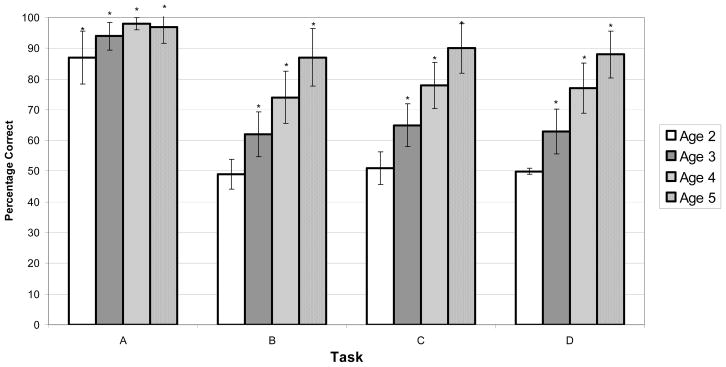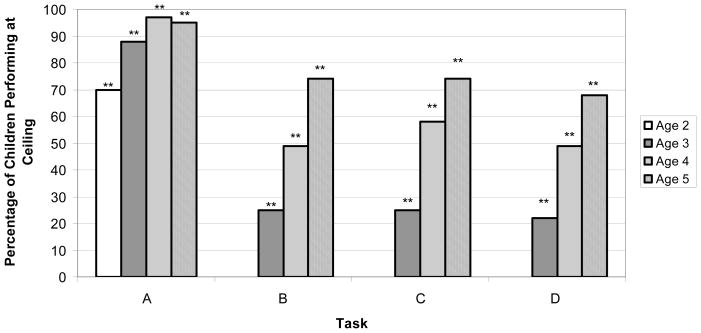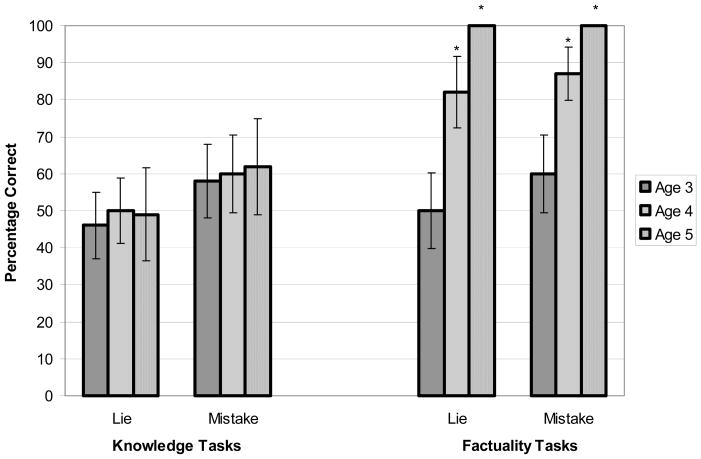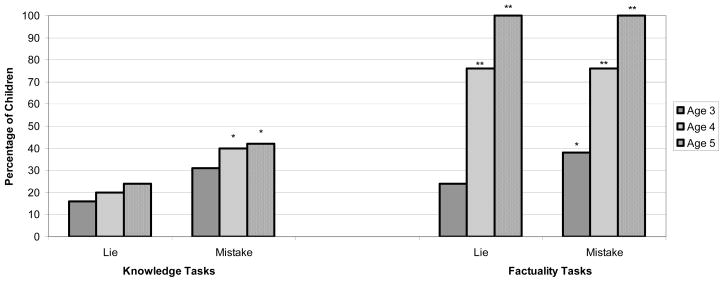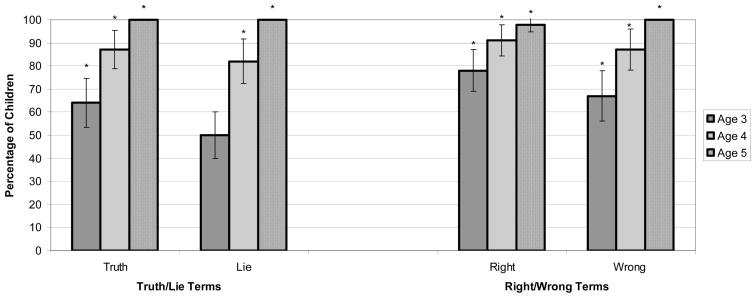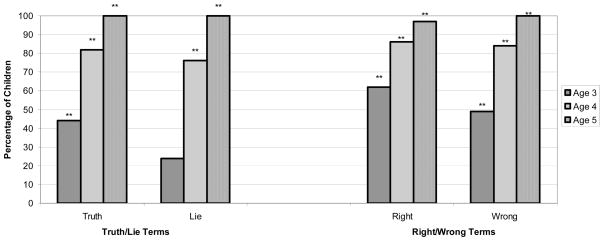Abstract
Two studies examined young children’s early understanding and evaluation of truth-telling and lying, and the role that factuality plays in their judgments. Study 1 (104 2- to 5-year-olds) found that even the youngest children reliably accepted true statements and rejected false statements, and that older children’s ability to label true and false statements as “truth” and “lie” emerged in tandem with their positive evaluation of true statements and “truth” and their negative evaluation of false statements and “lie.” The findings suggest that children’s early preference for factuality develops into a conception of “truth” and “lie” that is linked both to factuality and moral evaluation. Study 2 (128 3- to 5-year-olds) found that, whereas young children exhibited good understanding of the association of true and false statements with “truth,” “lie,” “mistake,” “right,” and “wrong,” they showed little awareness of assumptions about speaker knowledge underlying “lie” and “mistake.” The results further support the primacy of factuality in children’s early understanding and evaluation of truth and lies.
Beginning with Piaget (1932), a great deal of research has examined children’s incipient understanding of the truth and lies (Lee, 2000; Peterson, Peterson, & Seeto, 1983; Strichartz & Burton, 1990; Talwar & Lee, 2008; Wimmer, Gruber, & Perner, 1984, 1985). Nevertheless, several questions remain unanswered. First, although there is general agreement that children exhibit an early understanding of factuality that—”truth” refers to true statements and “lie” to false statements -- the origins of this understanding are unknown. Second, children’s incipient understanding of the wrongfulness of lying has similarly gone undocumented. As a result, the relation between children’s understanding of factuality and their earliest moral evaluation of true and false statements has never been explored. Third, although most research has supported Piaget’s original claim that children understand that lies are false before they understand that lies are intentional (Peterson et al., 1983; Strichartz & Burton, 1990; Talwar & Lee, 2008; Wimmer et al., 1984, 1985), this claim has been challenged by research suggesting that young children are capable of distinguishing between lies and mistakes if the tasks are sufficiently sensitive to that understanding (Gilli, Marchetti, Siegal, & Peterson, 2001; Siegal & Peterson, 1996, 1998).
The Emergence of Children’s Understanding of “Truth” and “Lie”
Research examining children’s understanding of “truth” and “lie” has found that even preschoolers understand that lies are counterfactual statements (Bussey, 1992, 1999; Haugaard, Repucci, Laird, & Nauful, 1991); however, the youngest children tested in most studies were four years of age. The only study examining younger children’s use of the terms “truth” and “lie” enrolled 3-year-olds and found little or no understanding of factuality among children that young (Strichartz & Burton, 1990). However, the methodology of that study has been criticized as unduly complex (Siegel & Peterson, 1996); indeed, the authors acknowledged the possibility that “the decision-making task itself was too difficult for these very young children” (Strichartz & Burton, 1990, p. 217), pointing to the fact that 37% of the 3-year-olds had to be dropped from the study due to non-responsiveness. In related research, Mascaro and Sperber (2009) found that 4-year-olds but not 3-year-olds mistrusted a speaker who was described as “a big liar.” However, 3-year-olds’ failure could be due to their executive functioning difficulties in rejecting the speaker’s directions rather than their awareness that “lie” denotes inaccuracy. Indeed, Perner (1997) has noted that even 2-year-olds exhibit some understanding of the counterfactual aspect of the concept of lying, based on findings that, before their second birthday, children tend to reject counterfactual statements by objecting to false propositions (Koenig & Echols, 2003; Pea, 1982) and by denying false propositions expressed in question form (Hummer, Wimmer, & Antes, 1993; Pea, 1980).
Together, extant research raises an important distinction between the ability to reject counterfactual statements and the ability to label counterfactual statements as such. The latter requires a more explicit, declarative representation of truth and falsity (Dienes & Perner, 1999; Karmiloff-Smith, 1992) and entails labeling the act of labeling, a form of metalinguistic thinking that reflects an important linguistic and conceptual developmental achievement. A child who has obtained a declarative understanding of truth and falsity can talk about statements as true or false, begin to reason about truth and falsity, and identify others as accurate or inaccurate. Indeed, several studies indicate that children’s appreciation of others’ accuracy affects their trust in others’ knowledge (Koenig & Harris, 2008). The emergence of this ability also has legal significance; in order to quality as testimonially competent, children in United States courts are often asked about their understanding of “truth” and “lie” (Lyon, 2011).
The earliest signs of children’s ability to identify true and false statements as such have been detected in research that did not explicitly reference the terms “truth” and “lie.” Donaldson and Lloyd reported that they were able to train children as young as 3 ½ years to judge whether sentences were “right” or “wrong” (Donaldson & Lloyd, 1974; Lloyd & Donaldson, 1976). More recently, Koenig, Clement, and Harris (2004) presented children with multiple trials in which two characters consistently labeled objects correctly or incorrectly. Even 3-year-olds were above chance in identifying which person “kept saying something right” or “kept saying something wrong.”
It seems likely, therefore, that children’s ability to accept true statements and reject false statements emerges before their ability to label true and false statements as such, but no research has directly compared children’s performance on these tasks. Furthermore, children’s ability to identify accurate and inaccurate statements and speakers by 3 ½ years of age suggests that children’s understanding of the factuality component of “truth” and “lie” might emerge at this age as well.
The Emergence of Children’s Moral Evaluation of Truth and Lies
The earliest emergence of children’s moral evaluation of counterfactual statements has also escaped notice. Research on children’s understanding of truth and lies has found that young children have a basic understanding of the wrongfulness of lying, but again, the youngest children studied were 4 years of age (Bussey, 1992, 1999; Peterson, et al., 1983). Moreover, as with studies of children’s understanding of the meaning of lying, studies often relied on complicated scenarios that may have masked evidence of early understanding of counterfactuality as presumptively wrongful. For example, Bussey (1992) found that 4-year-olds exhibited little appreciation of the moral goodness of truth-telling, but the scenarios that revealed this pattern involved wrongdoing by a truth-teller, thus potentially confusing children regarding the event they were expected to evaluate (i.e., the act versus the individual). A more sensitive approach may be to ask children about behavior that is not inherently wrongful. For example, in tasks in which one of two persons mislabeled objects, 3-year-olds indicate that the person is “not very good at answering these questions” (Koenig & Harris, 2005; Pasquini, Corriveau, Koenig, & Harris, 2007).
Because prior research has failed to examine the emergence of a factuality understanding of truth and lies or the earliest age at which children assess lying negatively, whether children’s awareness of counterfactuality emerges in tandem with their moral evaluation of counterfactual statements is unknown (Lee, 2000). In other words, it is unknown whether children conclude that false statements are bad at the same time that they conclude such statements are lies. Prior research has failed to answer this question, in large part because it has assessed children’s definitional and evaluative understanding utilizing different scenarios or different scales (e.g., Bussey, 1992). On the one hand, there may be a close relation between children’s understanding of the meaning and morality of lying. If children’s implicit awareness of counterfactuality is conveyed through their rejection of counterfactual statements, which reflects a preference for factuality, their explicit awareness of counterfactuality might then be exhibited through both definitional and evaluative labeling (i.e. “truth/lie” and “good/bad”). A false statement violates a simple norm. It is thus reasonable to posit that children view norm violations as presumptively immoral (or perhaps as wrong in a social conventional sense, Nucci & Turiel, 1978) in the absence of additional justification. It is probably not a coincidence that the terms “right” and “wrong” conflate factuality and morality.
On the other hand, however, children’s conceptual and evaluative judgments may also develop separately. Children might learn that “the truth” and “lies” are “good” or “bad” before they understand the meaning of the words. Some evidence indicates that young maltreated children exhibit this tendency (Lyon, Carrick, & Quas, 2010; Lyon & Dorado, 2008; Lyon & Saywitz, 1999). Moreover, young children seem to understand the negative connotations of “lie” better than its denotation: Young children sometimes overextend the word “lie” to include bad words (Peterson et al., 1983; Piaget, 1932). Similarly, the negative connotations of the word “lie” may mask children’s understanding of the moral distinctions between intentionally false and unintentionally false statements. Wimmer et al. (1985) found that children were more likely to label mistakes as immoral if they had first been asked to label them as “truth” or “lie.”
The Emergence of Children’s Understanding of the Intentionality of Lies
Numerous studies concerning the role of intentionality in children’s emerging understanding of lies suggest that children label unintentional falsehoods as lies well into their grade school years (Peterson et al., 1983; Piaget, 1932; Strichartz & Burton, 1980; Wimmer et al., 1984). For example, Wimmer et al. told children two types of stories. In the first type, one child lied to a second child, who then innocently repeated the false statement, believing it to be the truth. Even 10-year-olds called the second child’s innocent statement a lie. In the second type, a child formed a false belief due to a lack of perceptual access; 4- and 6-year-olds called those false statements lies, whereas 8-year-olds usually denied that they were lies. Strichartz and Burton (1980) also found that children mislabeled false statements based on a lack of perceptual access; virtually all first graders (and 50% of fifth graders) called such statements lies.
These studies may have underestimated young children’s incipient understanding of unintentional falsehoods, however. Children may be more proficient at recognizing that honest mistakes are not lies than they are at evaluating guesses in which the speaker is clearly aware of his or her ignorance, because in the latter case the speaker is blameworthy for giving a response that he or she knows might be false. Children may be better at identifying mistakes as such when the speaker’s ignorance is made explicit than they are at evaluating lies that are innocently repeated, or statements that are the product of false beliefs.
The primary challenge to research suggesting the primacy of factuality in children’s definition of truth and lies was presented by Siegal and colleagues, who attempted to simplify the procedures involved in assessing the role of intentionality in children’s understanding of the distinction between lies and mistakes (Gilli et al., 2001; Siegal & Peterson, 1996, 1998). Children compared two characters who falsely claimed that food was safe to eat after being contaminated by insects. One character watched the insects touch the food, and the other had his back turned and did not see. When asked whether each character lied or made a mistake, even 3-year-olds performed very well on the tasks, particularly when the knowledge states of the characters were emphasized.
However, the research by Siegal and colleagues does not resolve the question of whether factuality predominates in children’s earliest understanding of truth and lie. First, Siegal and colleagues’ (1996) argued that children’s early understanding of intentionality only exists in the domain of food contamination. The 3-year-olds were at chance on a comparable task in which the false statement concerned whether a door was locked (Study 3). Similarly, 4-year-olds were unable to distinguish between a lie and mistake when a character provided erroneous information about the location of a sweet (Mascaro & Sperber, 2009). Second, Siegel and Peterson (Study 5; 1996) found that, when asked, “Was that a lie?” children universally affirmed that mistaken statements were lies. Thus, consistent with the view that factuality predominates in children’s early understanding, children may believe that unintentionally false statements are both lies and mistakes. In particular, if any false statement is a lie, and a mistake is an unintentional false statement, then a mistake is a type of lie (see also Piaget, 1932). Third, even if young children appreciate the unintentionality of mistakes, this begs the question of the role of factuality in their early labeling of true and false statements as the truth and a lie. That is, no research has explored in a comprehensive manner the relative roles of factuality and speaker knowledge in labeling false statements as “mistakes.”
The Current Research
Our goal in this research was to assess children’s emergent understanding of the meaning and morality of true and false (T/F) statements. In Study 1, we developed four parallel tasks: A) Accept/reject T/F statements, which tested children’s proclivity to accept or reject T/F statements; B) Label T/F statements as truth/lie, which tested children’s ability to label T/F statements as “truth” or “lie”; C) Label T/F statements as good/bad, which tested children’s ability to label T/F statements as “good” or “bad”; and D) Label truth/lie as good/bad, which tested children’s ability to label the words “truth” and “lie” as “good” or “bad.” We first hypothesized that children would accept true statements and reject false statements before they consistently labeled T/F statements (A > B, C, and D). Second, we hypothesized that children’s performance on the labeling tasks would be correlated, such that their awareness of the meaning and morality of T/F statements would emerge in tandem (B=C=D). We also tested the alternative hypothesis that there would be differences among the labeling tasks: 1) children might understand the connotations of “truth” and “lie” before understanding their denotations (D > B), and 2) children might label T/F statements as “good” or “bad” before recognizing them as”truth” or “lies” (C > B).
In Study 2, we compared children’s ability to label T/F statements as “truth,” “lie,” “mistake,” “right,” and “wrong” to their understanding of speaker knowledge distinctions between “lie” and “mistake.” We hypothesized that children’s understanding of the role of factuality in the terms would emerge earlier than their understanding of the role of speaker knowledge.
STUDY 1
Method
Participants
Participants included 101 children (45 girls and 56 boys), ages 2 to 5 years: 17 2-year-olds (M = 2–7; range 2–3 to 2–11), 32 3-year-olds (M = 3–7; range 3-0 to 3–11)1, 33 4-year-olds (M = 4–6; range 4-0 to 4–11) and 19 5-year-olds (M = 5-5; range 5-0 to 5–11). Because we anticipated that most of the developmental changes would occur among the 3- and 4-year-old children, we oversampled children in this age range. Children were recruited from local childcare centers that serve predominantly middle- to upper-middle-class families. 67% of the children were Caucasian, 16% were Asian-American, 10% were African-American, 4% were Hispanic and 3% were mixed ethnicities or unknown.
Materials and Procedure
Relevant Institutional Review Boards approved all procedures. Only children with parental consent participated and were tested individually in their childcare centers.
Children’s understanding was assessed across four tasks with eight trials per task: A) Accept/reject T/F statements, B) Label T/F statements as truth/lie, C) Label T/F statements as good/bad, and D) Label truth/lie as good/bad (see Figure 1). Each task consisted of eight yes/no questions, with the number of questions about “truth” or “lie,” “good” or “bad,” true statements or false statements, being equal within tasks. The order in which the tasks were administered was counterbalanced using a Latin square design. Within each task, the order of the correct responses ensured that a bias to alternate responses (yes/no or no/yes) would lead to chance performance.
Figure 1. Summary of Study 1 Tasks and Sample Images.
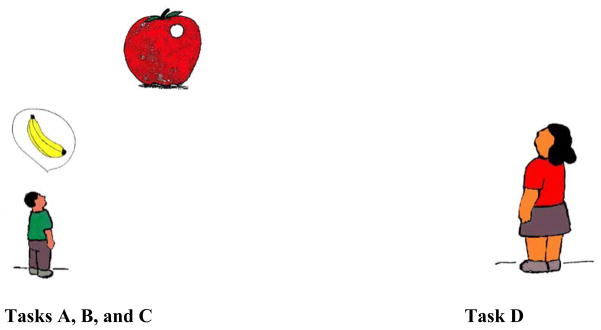
A) Accept/reject T/F statements: This [child] looks at the X and says it is a X/Y. Is this a X/Y?
B) Label T/F statements as truth/lie: This [child] looks at the X and says it is a X/Y. Did the [child] tell the truth?/ Did the [child] tell a lie?
C) Label T/F statements as good/bad: This [child] looks at the X and says it is a X/Y. Did the [child] say something good?/ Did the [child] say something bad?
D) Label truth/lie as good/bad: [This child] tells the truth/a lie. Did [the child] say something good?/Did [the child] say something bad?
For tasks A, B, and C, each trial depicted a target object and a story child with a talk bubble containing a drawing of the target object (four trials) or a different object (four trials). The experimenter first pointed to the target object and asked the participant, “What is this?” and accepted the participant’s label. The experimenter then said, pointing to the story child, “This boy (or girl) looks at the [participant’s label] and says ‘It’s a [object in talk bubble].” For example, in a story in which the story child made a false statement (e.g., called an apple a banana), the experimenter said, “This boy looks at the apple and says, ‘It’s a banana.’”
The specific questions then asked of the participant varied across tasks. In task A (Accept/reject T/F statements task), the experimenter pointed at the target object and asked, “Is this a [object in talk bubble]?” In task B (Label T/F statements as truth/lie task), the experimenter asked the participant, “Did the boy/girl tell the truth?” or “Did the boy/girl tell a lie?” In task C (Label T/F statements as good/bad task, the experimenter asked the participant), “Did the boy/girl say something good” or “Did the boy/girl say something bad?”
For task D (Label truth/lie as good/bad task), each trial only depicted a story child. The experimenter told the participant the name of the story child (to reduce the monotony of the stories), and said that the story child either “told the truth” or “told a lie,” then asked, “Did s/he say something good?” or “Did s/he say something bad?”
Children received a “1” for each correct response and a “0” for each incorrect response. Children responded “don’t know” or incomprehensibly less than 2% of the time across the four tasks; these responses were coded as “.5” so that a failure to answer would be comparable to guessing.
Results
The significance level was set at p < .05. Preliminary analyses revealed that children’s performance was not significantly related to gender, ethnicity, or order of task presentation, and these factors were not considered further.
Children’s performance across the four tasks separated by age group is shown in Figure 2. We first tested for differences in overall performance across the four tasks. A repeated measures analysis of variance (ANOVA) was conducted with children’s scores on the four tasks (A, B, C, and D) as a within-subjects factor and age (2, 3, 4 or 5 years) as a between-subjects factor. Significant main effects of age, F (3, 97) = 18.65, ηp2 = .37, task, F (3, 291) = 70.93 ηp2 = .42, emerged, as did a significant age X task interaction, F (9, 291) = 3.94, ηp2 = .11. Pairwise comparisons, using Bonferroni adjustments for multiple comparisons, showed that children did better with age and that all ages performed best on task A, Accept/reject T/F statements, except that the 5-year-olds were near-ceiling on all tasks. Children’s performance on the B, C, and D tasks (Label T/F statements as truth/lie, Label T/F statements as good/bad, and Label truth/lie as good/bad) did not differ. Indeed their performance across these three tasks was highly correlated (all rs ≥ .68, p < .001). In order to ensure that the correlations were not simply due to the youngest children performing at floor and the oldest children at ceiling, we also calculated the correlations for only the 3- and 4-year-olds, and the same pattern held (all rs > .60, p < .001). Hence, there was clear support for our predictions that children would be better at accepting/rejecting T/F statements than labeling T/F statements, and that children’s labeling of T/F statements as “truth”/”lie” would be comparable to their labeling of T/F statements and “truth”/”lie” as “good”/”bad.”
Figure 2. Percentage Correct Across Tasks by Age in Study 1.
Note. Asterisks correspond to means that significantly differed from chance (50% accuracy). Error bars reflect confidence intervals.
To identify the age at which children’s understanding emerged, their performance was compared to chance at each age. Whereas 2-year-olds were above chance only when accepting or rejecting T/F statements (task A; 88% correct), older children were above chance on all the tasks (Figure 2). Children’s individual responses were examined (Figure 3) to estimate the proportion of children at each age who performed at ceiling. We defined ceiling performance as 7 or 8 (out of 8) correct, because the likelihood that any individual child would do so by chance is less than 5%. A significant percentage of the 2-year-olds (70%) were at ceiling in accepting or rejecting T/F statements (task A), but none of the 2-year-olds was at ceiling on the B, C, or D tasks. Significant numbers of children in the three older groups were at ceiling on each of the tasks. Across the three labeling tasks (B, C, and D), approximately 25% of the 3-year-olds were at ceiling, 50% of the 4-year-olds, and 70% of the 5-year-olds.
Figure 3. Percentage of Children Performing at Ceiling Across Tasks by Age in Study 1.
Note. Ceiling performance was calculated as responding correctly to 7 or 8 out of 8 trials. Asterisks indicate that the number of children who performed at ceiling was significantly greater than what would be expected by chance at **p < .01.
Next, we evaluated more precisely the age at which children began to exhibit understanding on the B, C, and D tasks by separating younger (3–5 and younger) (N = 14) and older (3–6 and older) 3-year-olds (N = 17). Whereas only one of the younger 3-year-olds was at ceiling on any of these tasks, over a third of the older 3-year-olds were at ceiling on each of the tasks.
Finally, we conducted exploratory analyses to determine if children performed differently when the task used the word “truth” or “lie” (tasks B and D) or when the story child’s statements were true or false (tasks A, B, and C) via two separate age X task ANOVAs. We found that children performed better when asked about the “truth” than when asked about a “lie” on both task B (Label T/F statements as truth/lie), F (1, 97) = 3.87, ηp2 =.038, and task D (Label truth/lie as good/bad), F (1, 97) = 6.24, ηp2 = .06. With respect to true and false statements, children’s performance did not differ on task A (Accept/reject T/F statements) and B (Label T/F statements as truth/lie), but children performed better when asked about true statements than when asked about false statements on task C (Label T/F statements as good/bad), F (1, 97) = 13.81, ηp2 = .125. None of these differences significantly interacted with age. Hence, children exhibited somewhat better understanding of “truth” than “lie” and were more accurate in evaluating the goodness/badness of statements when evaluating true statements.2
Discussion
Three primary findings emerged in Study 1. First, we found support for the proposition that children’s initial implicit awareness of truth and falsity, as reflected by their acceptance of true statements and rejection of false statements, develops into an articulable understanding that true statements are the “truth” and “good,” and false statements are “lies” and are “bad.” Second, we found that children’s ability to label true and false statements as “truth” and “lie” emerged in tandem with their positive evaluation of true statements and “truth” and their negative evaluation of false statements and “lie.” And third, children performed better when answering questions about the “truth” than about “lies,” and that children were better at assessing true statements than false statements when asked if the statements were “good” or “bad.” These findings are novel since prior research has not found differences in understanding (e.g. Haugaard et al., 1991) and suggest that young children may have an aversion to applying and assessing the word “lie,” reminiscent of a positivity bias among young children to avoid negative assumptions about behavior (Boseovski, 2010).
It is possible that children’s difficulty with labeling the word “lie” was due to an inference that the false statement was a mistake rather than a lie. This is unlikely for two reasons. First, the tasks themselves described the characters as looking at the objects being labeled; the objects were easily recognizable to even the youngest children. Second, as noted above, numerous prior studies concerning the role of intentionality in children’s emerging understanding of lies suggest that children label unintentional falsehoods as lies well into their grade school years (e.g., Peterson et al., 1983; Piaget, 1932).
Yet, prior research may have underestimated children’s understanding of the importance of intentionality in labeling statements as lies. Therefore, Study 2 was designed to compare children’s recognition of the role of speaker knowledge in using the terms “lie” and “mistake” to their association of the terms with T/F statements. Several aspects of the approach of Study 2 are important to note. First, in order to make perceptual access and knowledge highly salient, the perceptual access and knowledge states of the characters were both explicitly stated and visually depicted, so that children neither had to infer nor recall this information. Second, we created stories of equal complexity across all tasks, so that when we compared children’s relative appreciation of the role of factuality and knowledge, task complexity was not a potential confound. This necessarily entailed adding details to the stories assessing children’s factuality understanding that were not essential to their judgment (perceptual access and knowledge), providing a less sensitive test of the earliest emergence of factuality understanding. Third, in order to determine when children were first aware of the unintentionality of mistakes, we created stories in which children were asked to choose which of two characters “made a mistake,” one with knowledge and perceptual access and one without. Parallel stories asked children which of two characters “told a lie.” Unlike in Study 1, we did not ask yes/no questions because this could obscure understanding of the unintentional nature of mistakes. That is, a child asked yes/no questions might affirm that both intentionally and unintentionally false statements are lies (and mistakes), but if forced to choose, might correctly label the unintentional statement as the mistake.
We created two types of tasks: factuality tasks and knowledge tasks. In the factuality tasks, the two characters differed in terms of the factuality of their statements (holding knowledge constant). In the knowledge tasks, the two characters differed in terms of their knowledge (holding factuality constant). We predicted that children would perform better on the factuality tasks than on the knowledge tasks, which would support the primacy of the factuality rule in children’s judgments. Finally, we tested a new pair of terms, “right” and “wrong,” terms that might reveal the earliest indication of children’s understanding of factuality because the terms refer to the accuracy or inaccuracy of statements and have clear moral connotations but do not imply anything about the knowledge states of the speakers.
STUDY 2
Method
Participants
Participants included 128 children (65 girls and 63 boys), ages 3 to 5 years: 45 3-year-olds (M = 3–6; range 3-0 to 3–11), 50 4-year-olds (M =4–5; range 4-1 to 4–11), 33 5-year-olds (M = 5-3; range 5-0 to 5–11), none of whom participated in Study 1. Children were recruited from local childcare centers that serve predominantly middle- to upper-middle-class families. 57% of the children were Caucasian, 16% were Hispanic, 13% were Asian-American, 5% were African-American, and 4% were other or unknown.
Materials and Procedure
Relevant Institutional Review Boards approved all procedures. Only children with parental consent participated and were tested individually in their childcare centers.
Children’s understanding was assessed across two story tasks: a knowledge task (“lie,” “mistake”), and a factuality task (“truth,” “lie,” “mistake,” “right,” “wrong”) (See Figure 4). In each task, simple pictures, similar to those included in Study 1, accompanied the stories. The pictures depicted a target object and two story children, one on each side of the object. Each story child was accompanied by a talk bubble that depicted what the child said about the target object.
Figure 4. Summary of Study 2 Tasks and Sample Images.
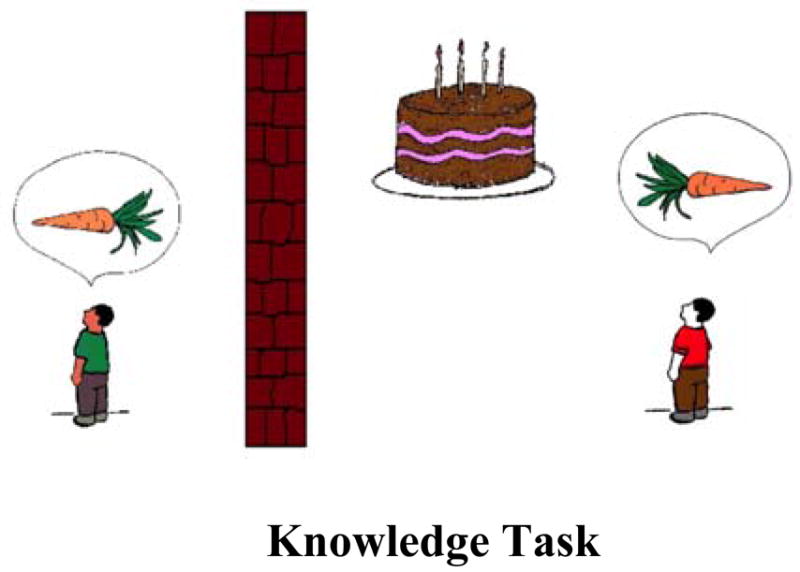
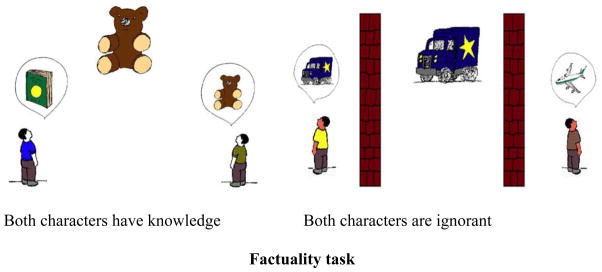
A) Knowledge task (“lie” & “mistake”)
The story children vary in knowledge, but both make inaccurate statements.
This boy [boy on left] DOES NOT see the [target object]. He DOES NOT KNOW it is a [target object]. He says: it’s a [inaccurate label].
This boy [boy on right] SEES the [target object]. He KNOWS it is a [target object]. He says: it’s a [inaccurate label]
Which boy told a lie? (2 stories)/Which boy made a mistake? (2 stories)
B) Factuality task (“truth,” “lie,” “mistake,” “right,” & “wrong”)
The story children vary in accuracy, but both have knowledge (“truth,” “lie,” “right,” & “wrong”) or both are ignorant (“mistake”).
This boy [boy on left] SEES the [target object]. He KNOWS it is a [target object]. He says: it’s a [target object].
This boy [boy on right] SEES the [target object]. He KNOWS it is a [target object]. He says: it’s a [inaccurate label].
Which boy told the truth? (2 stories) /Which boy told a lie? (2 stories)/Which boy said something right? (2 stories)/Which boy said something wrong? (2 stories)
This boy [boy on left] DOES NOT see the [target object]. He DOES NOT KNOW it is a [target object]. He says: it’s a [target object].
This boy [boy on right] DOES NOT see the [target object]. He DOES NOT KNOW it is a [target object]. He says: it’s a [inaccurate label].
Which boy made a mistake? (2 stories)
The knowledge task assessed children’s understanding that “lie” refers to knowingly false statements and “mistake” refers to unknowingly false statements. The factuality task assessed children’s understanding that “truth” and “right” refer to true statements and that “lie,” “mistake,” and “wrong” refer to false statements. In each task, either the accuracy of the story children’s statements was held constant (knowledge task) or the story children’s knowledge state was held constant (factuality task). Children were presented with a total of 14 stories, with 2 stories for each term within each task. The tasks were counterbalanced using a Latin Squares design to control for any order effects. The position of the correct story child alternated so that children with a position bias or a bias toward alternating their choice trial by trial would score at chance.
Children received a 1 for each correct response and a 0 for each incorrect response. Children responded “don’t know” or incomprehensibly less than 1% of the time; these responses were coded as .5, or chance responding. Children’s responses were averaged to obtain accuracy scores.
Results
The significance level was set at p < .05. As in Study 1, children’s performance was not significantly related to gender, ethnicity, or order of task presentation, and none is considered further.
Children’s performance on “lie” and “mistake” across the factuality and knowledge tasks by age is shown in Figure 5. The first analysis tested our prediction that children would perform better on the stories contrasting factuality than on the stories contrasting speaker knowledge, and compared children’s performance on “lie” and “mistake” stories within each task. We conducted a repeated measures ANOVA with children’s scores on the two tasks (factuality, knowledge) and term (“lie,” “mistake”) as within-subjects factors and age (3, 4, or 5 years) as a between-subjects factor. Results revealed significant main effects of age, F (2, 125) = 19.79, ηp2 = .24, task, F (1, 125) = 87.38, ηp2 = .41, and term, F = (1, 125) = 8.67, ηp2 = .07, as well as a significant age X task interaction, F (2, 125) = 18.70, ηp2 = .230. Pairwise follow-up comparisons with Bonferroni corrections were conducted to interpret the significant effects. Across age, children were better at identifying mistakes, M = .71, than lies, M = .63. The interaction revealed that 4- and 5-year-olds performed better on the factuality task than on the knowledge task, whereas the 3-year-olds performed equally poorly on both tasks.3
Figure 5. Percentage Correct Across the Knowledge and Factuality Tasks, “Mistake” vs. “Lie,” by Age in Study 2.
Note. Asterisks correspond to means that significantly differed from chance (50% accuracy). Error bars reflect confidence intervals.
To identify the age at which children’s understanding emerged, their performance at each age on each term within each task was compared to chance (Figure 5). On the factuality task, children scored above chance by 4 years of age, whereas on the knowledge task, not even the oldest children (5-year-olds) scored above chance. Children’s individual responses were also examined to estimate the proportion of children at each age who performed at ceiling on each term within each task (2/2 correct) (Figure 6). On the factuality task, significant numbers of children at every age exhibited good understanding of “mistake,” and by age four years, children exhibited good understanding of “lie.” Comparing younger 3s (n = 20) to older 3s (n = 25) on the factuality “mistake” stories revealed that it was only among the older group that a significant number scored at ceiling (44%). On the knowledge task, significant numbers of children by four years of age scored at ceiling at “mistake,” whereas not even the oldest children evinced understanding that only intentionally false statements are lies.
Figure 6. Percentage of Children Performing at Ceiling Across Tasks, “Mistake” vs. “Lie,” by Age in Study 2.
Note. Ceiling performance was calculated as responding correctly to 2 out of 2 trials. Asterisks indicate that the number of children who performed at ceiling was significantly greater than what would be expected by chance at *p < .05 or **p < .01.
Taken together, the analyses thus revealed that although 3-year-olds as a group exhibited little understanding of either “mistake” or “lie,” some 3-year-olds understood the counterfactuality of “mistake.” Also, although none of the age groups exhibited good understanding on the knowledge task, some children by 4 years of age understood that ignorance underlies a “mistake.”
The second analysis tested whether children performed better on the factuality task when the terms were “right” and “wrong” than when the terms were “truth” and “lie,” and whether children performed better on the positively valenced terms (“right” and “truth”) than on the negatively valenced terms (“wrong” and “lie”) (Figure 7). (Note that children’s performance on the factuality “lie” trials was assessed in the previous analyses in comparison to children’s understanding of “mistake,” and in these analyses to “truth,” “right,” and “wrong”). We conducted a repeated measures ANOVA with children’s scores on “right”/”wrong” versus “truth”/”lie” and “right”/”truth” versus “wrong”/”lie” as within-subjects factors and age (3, 4, or 5 years) as a between-subjects factor. Main effects of age, F (2, 125) = 35.89, ηp2 = .365, term, F (1, 125) = 9.58, ηp2 = .071, and valence, F (1, 125) = 5.03, ηp2 = .039, emerged. Overall, children’s performance increased with age. They also accurately labeled statements as “right”/”wrong” (M = .86) more often than as “truth”/”lie” (M = .79) and were more accurate with positively (“right”/”truth,” M =.87) than negatively (“wrong”/”lie”, M = .81) valenced terms. Finally, an age X term interaction, F (2, 125) = 5.12, ηp2 = .076, revealed that accuracy for “right”/”wrong” was only significantly better than “truth”/”lie” among the 3-year-olds.
Figure 7. Percentage Correct on the Factuality Task, “Truth” vs. “Lie” and “Right” vs. “Wrong,” by Age in Study 2.
Note. Asterisks correspond to means that significantly differed from chance (50% accuracy). Error bars reflect confidence intervals.
Children’s performance on each term at each age was compared to chance, and with the exception of 3-year-olds on the “lie” trials, children were above chance on all the terms (Figure 7). The analyses for the number of children at ceiling were similar, with significant number of children at all ages at ceiling on all the terms, with the exception of 3-year-olds on the “lie” trials (Figure 8). Comparing younger 3s (n = 20) to older 3s (n = 25) on the “truth,” “right” and “wrong” trials revealed that only among the older group did a significant number of children score at ceiling (the percentages ranged from 44% to 80%).
Figure 8. Percentage of Children Performing at Ceiling on the Factuality Task, “Truth” vs. “Lie” and “Right” vs. “Wrong”, by Age in Study 2.
Note. Ceiling was calculated as 2/2 correct on each task. Asterisks indicate that the number of children who performed at ceiling was significantly greater than what would be expected by chance at **p < .01.
Discussion
Our predictions in Study 2 were supported. Children performed better on the factuality task than on the knowledge task when assessing which character had made a “mistake” or was telling a “lie.” Even the 3-year-olds exhibited some understanding of the counterfactuality of mistakes, whereas it was not until 4 years of age that children showed any evidence of understanding the ignorance underlying mistakes. With respect to using the word “lie,” factuality understanding also preceded knowledge understanding, and both uses of the word lagged behind children’s understanding of “mistake.” Children also performed better when asked which character was “right” or “wrong,” (compared to “truth” and lie”). Given the fact that the knowledge states of the speakers were unambiguous and were both verbally described and visually depicted, and given the lack of other story elements that might complicate the task and confuse children, the results clearly support the proposition that factuality predominates in children’s initial understanding of truth-telling and lying.
General Discussion
Two studies explored the role of factuality in children’s early labeling and evaluation of true and false statements. Several noteworthy trends emerged. First, Study 1 suggested that children’s implicit awareness of T/F statements, as reflected by their acceptance of true statements and rejection of false statements, develops into an articulable concept captured by the words “truth,” “lie,” “good,” and “bad.” Even the youngest children (2-year-olds) reliably accepted true statements and rejected false statements, but children did not reliably label T/F statements as such until they were between 3 ½ and 4 years of age. Second, children’s ability to label statements as truth or lie emerged in tandem with their negative evaluation of false statements. Once children recognized T/F statements as “truth” or “lie,” they concurrently labeled T/F statements as “good” or “bad,” and identified “truth” and “lie” and “good” and “bad.” Unlike previous research, our use of parallel tasks in Study 1 enabled us to test for potential differences in the development of children’s awareness of the counterfactual nature of lies and the immorality of lies. We propose that children’s understanding of the meaning and morality of “truth” and “lie” emerges between 3 ½ and 4 years of age, and operates under a factuality rule: If a statement is factual, it is the “truth” and presumptively positive; if a statement is counterfactual, it is a “lie” and presumptively negative.
Study 2 further demonstrated the primacy of factuality in children’s labeling of T/F statements. Children appreciated the counterfactuality of “lie” and “mistake” at a younger age than they understood the epistemic assumptions underlying the use of the words. Study 2 is consistent with a number of studies showing that children understand that lies are false before they understand that lies are intentionally false (Peterson et al., 1983; Piaget, 1932; Strichartz & Burton, 1990; Talwar & Lee, 2008; Wimmer et al., 1984). Study 2 further extended findings from former studies to children’s understanding of mistakes utilizing stimuli that highlighted the knowledge states of the characters and thus minimized task complexity. Study 2 also found that “right” and “wrong,” words that for adults connote factuality and morality but assume nothing about speaker knowledge, appear to tap into children’s earliest ability to label T/F statements. We propose that children’s ability to use the terms “right,” “wrong,” “truth, “lie,” and “mistake” to label T/F statements emerges between 3 and 4 years of age, and that children exhibit some understanding that “mistake” refers to unintentionally false statements by 4 years of age.
An unanticipated finding in Study 1 was that children performed better when asked about “truth” than when asked about “lie,” and were better at evaluating true statements than false statements. Similarly, in Study 2 children’s performance was higher on positively than negatively valenced terms (“right” and “truth” versus “wrong” and “lie”). We suspect that children are exhibiting a type of positivity bias, in which they are reluctant to apply negative labels to behavior (Boseovki, 2010). This may also help to explain children’s better performance on “mistake” stories than on “lie” stories in Study 2, insofar as children recognize that “mistake” is less negative than “lie.” Significantly, children in Siegal and Peterson (1996, Study 5) who were unable to use speaker knowledge in labeling statements also appeared to exhibit a bias to choose “mistake” over “lie.” Whether children do in fact view “mistake” as less reprehensible than “lie” (independently of information about the speaker’s knowledge) is unknown, and worthy of direct test.
Another explanation for children’s superior performance on “mistake” compared to “lie,” at least with respect to the knowledge task, is that children initially view all false statements as lies, and therefore believe that unintentional false statements are both lies and mistakes. When asked which of two erring characters made a mistake, a knowledgeable or ignorant character, children with this view would perform well. However, when asked which character told a lie, children might choose randomly, since the forced choice question renders a “both” answer infelicitous. As discussed above, this possibility is consistent with Piaget’s (1932) interpretation of his results, and may help to explain the inconsistency in results between studies asking yes/no questions about lies and studies asking children to choose between “lie” and “mistake.”
The tasks utilized in the current studies provide a sensitive means of testing children’s early understanding of terms describing T/F statements and could be adapted to examine other related questions. If young children are insensitive to speaker knowledge when first attributing the word “lie” to false statements, an interesting question concerns how they first become capable of distinguishing lies and innocuous falsehoods, such as pretense (Taylor, Lussier, & Maring, 2003). We suspect that, whereas speaker knowledge is often difficult to ascertain (often requiring one to recall the speaker’s prior perceptual access or demonstration of knowledge), easily perceptible aspects of a situation contemporaneous with the speaker’s statement make distinctions possible. For example, speaker affect is likely important. Several studies have shown that 2-year-olds will selectively imitate pretend actions accompanied by positive affect but not mistaken actions or failed attempts (Hoicka & Gattis, 2008; Rakoczy & Tomasello, 2006). Future research should determine if children also use speaker expressiveness in determining whether to label false statements a “lie” or “pretending.”
A potential limitation to the studies was the exclusive focus on labeling of objects, which children may have viewed as an odd context within which to talk about lies. Children’s earliest lies concern wrongdoings--specifically denials of transgressions (Newton, Reddy, & Bull, 2000; Wilson, Smith, & Ross, 2003). Bussey (1999) has argued that children should be particularly adept at identifying lies about transgressions because they tend to be quite familiar with denials of wrongdoing, and also because parents tend not to reprimand children for other types of falsehoods. In contrast, children might viewed false statements about lies as jocular. This would provide another possible explanation for why children performed better on “truth” than on “lie” in Study 1, and possibly, at least if children view “wrong” as less negative than “lie,” why they performed better on “wrong” than on “lie” in Study 2. If the false statements explicitly mentioned misdeeds, children’s performance might have improved.
However, previous research has found that children do not hesitate to label joking statements as lies. Peterson et al. (1993) found that most children five to eleven years of age (and even half of adults) labeled as lies both exaggerations (e.g., claiming a chicken was as big as an elephant) and practical jokes (e.g., hiding an object and then revealing its location with a laugh). Thus, including wrongdoing in scenarios might improve children’s ability to label false statements as lies, but it could also impair their ability to label true statements as the truth. Given young children’s association of lying with badness, they may be biased to call all statements about wrongdoing lies. Bussey (1999) found that 25% of 4-year-olds mislabeled true admissions of wrongdoing as lies, whereas only about 10% of the 4-year-olds mislabeled false statements of wrongdoing as the truth. Future research could directly test whether inaccuracies in different contexts are easier or more difficult for young children to call lies.
In addition to the studies’ results advancing understanding of children’s linguistic, cognitive, and social development, the results are of practical importance. At least three implications emerge regarding how child witnesses are questioned in court. First, in a number of English-speaking countries, including the U.S., child witnesses are asked about their understanding of “truth” and “lie” in order to qualify as competent to take the oath (Lyon, 2011). The notion is, that in order to promise to tell the “truth,” the child must understand the meaning of the word “truth.” In other countries (and in a few states in the U.S.), children who fail the competency questions are allowed to testify unsworn (Lyon, 2011). The fact that children reliably reject false statements before they are capable of identifying false statements as such suggests the propriety of unsworn testimony. That is, children are capable of telling the truth before they are capable of correctly applying the word “truth”. Second, children’s superior performance on “truth” compared to “lie” suggests that when competency is tested, children should only be asked questions about the “truth”. Third, the scenarios presented to children to test their understanding should not incorporate information regarding the intent of the speakers, as this is likely to complicate the scenarios and impair performance.
In closing, these studies have elucidated children’s earliest understanding of fundamental linguistic distinctions between true and false statements. Children’s initial preference for factuality develops into an articulable conception of “truth” and “lie” linked both to factuality and to moral evaluation. At an early age, correctness is both right and presumptively righteous, whereas inaccuracies are both wrong and wrongful. Future research can explore how and in what contexts children are first capable of more subtle linguistic distinctions between different types of accuracies and inaccuracies.
Acknowledgments
Preparation of this article was supported in part by National Institute of Child Health and Human Development Grant HD047290. We appreciate the research assistance of Chava Frankiel, Megan Morrice, and Alexandra Harris.
Footnotes
Information concerning age in months for one 3-year-old was unavailable.
All of the task differences were confirmed via non-parametric tests.
Given the 5-year-olds’ ceiling performance on some words, we re-conducted the analyses excluding the oldest age group, and obtained consistent results.
Contributor Information
Thomas D. Lyon, University of Southern California
Jodi A. Quas, University of California, Irvine
Nathalie Carrick, California State University, Fullerton.
References
- Boseovski JJ. Evidence for “rose-colored glasses”: An examination of the positivity bias in young children’s personality judgments. Child Development Perspectives. 2010;4:212–218. [Google Scholar]
- Bussey K. Lying and truthfulness: Children’s definitions, standards, and evaluative reactions. Child Development. 1992;63:129–137. [Google Scholar]
- Bussey K. Children’s categorization and evaluation of different types of lies and truths. Child Development. 1999;70:1338–1347. [Google Scholar]
- Dienes Z, Perner J. A theory of implicit and explicit knowledge. Behavioral and Brain Sciences. 1999;22:735–808. doi: 10.1017/s0140525x99002186. [DOI] [PubMed] [Google Scholar]
- Donaldson M, Lloyd P. Sentences and situations: Children’s judgements of match and mismatch. In: Bresson F, editor. Problemes Actuels en Psycholinguistique. Paris: C.N.R.S; 1974. pp. 73–86. [Google Scholar]
- Gilli G, Marchetti A, Siegal M, Peterson C. Incipient ability to distinguish mistakes from lies: An Italian investigation. International Journal of Behavioral Development. 2001;25:88–92. [Google Scholar]
- Haugaard JJ, Reppucci ND, Laird J, Nauful T. Children’s definitions of the truth and their competency as witnesses in legal proceedings. Law and Human Behavior. 1991;15:253–271. [Google Scholar]
- Hoicka E, Gattis M. Do the wrong thing: How toddlers tell a joke from a mistake. Cognitive Development. 2008;23:180–190. [Google Scholar]
- Hummer P, Wimmer H, Antes G. On the origins of denial negation. Journal of Child Language. 1993;20:607–618. doi: 10.1017/s0305000900008503. [DOI] [PubMed] [Google Scholar]
- Karmiloff-Smith A. Beyond modularity: A developmental perspective on cognitive science. Cambridge, MA: MIT Press; 1992. [Google Scholar]
- Koenig MA, Clement F, Harris PL. Trust in testimony: Children’s use of true and false statements. Psychological Science. 2004;15:694–698. doi: 10.1111/j.0956-7976.2004.00742.x. [DOI] [PubMed] [Google Scholar]
- Koenig MA, Echols CH. Infants’ understanding of false labeling events: the referential roles of words and the speakers who use them. Cognition. 2003;87:179–208. doi: 10.1016/s0010-0277(03)00002-7. [DOI] [PubMed] [Google Scholar]
- Koenig MA, Harris PL. Preschoolers mistrust ignorant and inaccurate speakers. Child Development. 2005;76:1261–1277. doi: 10.1111/j.1467-8624.2005.00849.x. [DOI] [PubMed] [Google Scholar]
- Koenig MA, Harris PL. The basis of epistemic trust: Reliable testimony or reliable sources? Episteme. 2008;4:264–284. [Google Scholar]
- Lee K. Lying as doing deceptive things with words: A speech act theoretical perspective. In: Astington JW, editor. Mind in the making. Oxford: Blackwell; 2000. pp. 177–196. [Google Scholar]
- Lloyd P, Donaldson M. On a method of eliciting true/false judgments from young children. Journal of Child Language. 1976;3:411–416. [Google Scholar]
- Lyon TD. Assessing the competency of child witnesses: Best practice informed by psychology and law. In: Lamb ME, La Rooy D, Katz C, Malloy LC, editors. Children’s testimony: A handbook of psychological research and forensic practice. Sussex, U.K: Wiley-Blackwell; 2011. pp. 69–85. [Google Scholar]
- Lyon TD, Carrick N, Quas JA. Young children’s competency to take the oath: Effects of task, maltreatment, and age. Law & Human Behavior. 2010;34:141–149. doi: 10.1007/s10979-009-9177-9. [DOI] [PMC free article] [PubMed] [Google Scholar]
- Lyon TD, Dorado JS. Truth induction in young maltreated children: The effects of oath-taking and reassurance on true and false disclosures. Child Abuse & Neglect. 2008;32:738–748. doi: 10.1016/j.chiabu.2007.08.008. [DOI] [PMC free article] [PubMed] [Google Scholar]
- Lyon TD, Saywitz KJ. Young maltreated children’s competence to take the oath. Applied Developmental Science. 1999;3:16–27. [Google Scholar]
- Mascaro O, Sperber D. The moral, epistemic, and mindreading components of children’s vigilance towards deception. Cognition. 2009;112:367–80. doi: 10.1016/j.cognition.2009.05.012. [DOI] [PubMed] [Google Scholar]
- Newton P, Reddy V, Bull R. Children’s everyday deception and performance on false-belief tasks. British Journal of Developmental Psychology. 2000;18:297–317. [Google Scholar]
- Nucci L, Turiel E. Social interactions and the development of social concepts in preschool children. Child Development. 1978;49:400–407. [Google Scholar]
- Pasquini ES, Corriveau KH, Koenig M, Harris PL. Preschoolers monitor the relative accuracy of informants. Developmental Psychology. 2007;43:1216–1226. doi: 10.1037/0012-1649.43.5.1216. [DOI] [PubMed] [Google Scholar]
- Pea RD. The development of negation in early child language. In: Olson DR, editor. The social foundations of language and thought: Essays in honor of Jerome S Bruner. New York: Norton; 1980. pp. 156–186. [Google Scholar]
- Pea RD. Origins of verbal logic: Spontaneous denials by two- and three-year-olds. Journal of Child Language. 1982;9:597–626. doi: 10.1017/s0305000900004931. [DOI] [PubMed] [Google Scholar]
- Perner J. Children’s competency in understanding the role of a witness: Truth, lies, and moral ties. Applied Cognitive Psychology. 1997;11:S21–S35. [Google Scholar]
- Peterson CC, Peterson JL, Seeto D. Developmental changes in ideas about lying. Child Development. 1983;54:1529–1535. [PubMed] [Google Scholar]
- Piaget J. The moral judgment of the child. New York: MacMillan; 1932/1965. [Google Scholar]
- Rakoczy H, Tomasello M. Two-year-olds grasp the intentional structure of pretense acts. Developmental Science. 2006;9:557–564. doi: 10.1111/j.1467-7687.2006.00533.x. [DOI] [PubMed] [Google Scholar]
- Siegal M, Peterson CC. Breaking the mold: A fresh look at children’s understanding of questions about lies and mistakes. Developmental Psychology. 1996;32:322–334. [Google Scholar]
- Siegal M, Peterson CC. Preschoolers’ understanding of lies and innocent and negligent mistakes. Developmental Psychology. 1998;34:332–341. doi: 10.1037//0012-1649.34.2.332. [DOI] [PubMed] [Google Scholar]
- Strichartz AF, Burton RV. Lies and truth: A study of the development of the concept. Child Development. 1990;61:211–220. [PubMed] [Google Scholar]
- Talwar V, Lee K. Social and cognitive correlates of children’s lying. Child Development. 2008;79:866–881. doi: 10.1111/j.1467-8624.2008.01164.x. [DOI] [PMC free article] [PubMed] [Google Scholar]
- Taylor M, Lussier GL, Maring BL. The distinction between lying and pretending. Journal of Cognition & Development. 2003;4:299–332. [Google Scholar]
- Wilson AE, Smith MD, Ross HS. The nature and effects of young children’s lies. Social Development. 2003;12:21–45. [Google Scholar]
- Wimmer H, Gruber S, Perner J. Young children’s conception of lying: Lexical realism--moral subjectivism. Journal of Experimental Child Psychology. 1984;37:1–30. [Google Scholar]
- Wimmer H, Gruber S, Perner J. Young children’s conception of lying: Moral intuition and the denotation and connotation of “to lie. Developmental Psychology. 1985;21:993–995. [Google Scholar]



